Over the last few months, I’ve analyzed dozens of economic and business research reports, articles and analysis of President Trump’s economic plans. Over the next few months, I will analyze and write about President Trump’s proposed economic agenda in several articles. In Part One I will lay the ground work for these articles.
The President has assembled an impressive cabinet in regards to commerce and the economy. In general, most investors are very enthusiastic about this pro-business and growth administration. This bullishness is reflected in the markets. Most investors are not looking at the bearish case of these policies including the potential that these policies may be delayed, and the potential that some of these policies may have unintended consequences. I will write more about the bearish case as the bullish case is more than reflected in the markets.
President’s Priorities, Goals and Calendar
The President won in states (North Carolina, Wisconsin, Michigan, Ohio, and Pennsylvania) where workers lost their manufacturing jobs to outsourcing and automation. He wants to bring back, create high paying jobs for these workers.
For President Trump and the Republicans, they must meet the above mandate, create high paying jobs, to stay in power.
To meet their mandate, this administration will focus on these economic priorities:
- Corporate and individual tax cuts
- Repatriation of corporate profits overseas
- Deregulation
- Infrastructure and increased military spending
These policies and efforts are stimulative, and they could lead to higher economic and job growth.
Below is a forecasted calendar regarding the administration’s economic agenda:
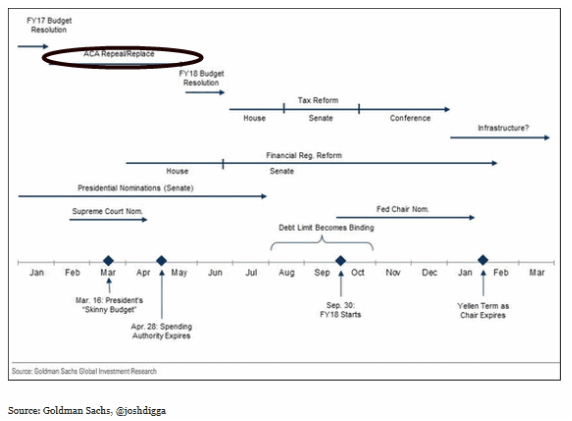
The biggest stimulative plans, tax cuts and infrastructure are expected to be passed in 2018 and probably won’t help the economy this year. This means the markets have probably gotten ahead of themselves.
Most of us believed that many of the President’s priorities would be passed because the President and both houses are all Republican. At the time of this writing, Republicans tried to pass their own healthcare plan and there were not enough votes to pass the plan. We are starting to learn that the President’s agenda will be harder to implement than anticipated.
Issues and Concerns Facing the Administration
There are many issues facing this administration that will make it difficult to fulfill all of its goals. Basically the U.S. and global economy and geopolitical concerns are much more complicated, and get larger for each new administration. The challenges the U.S. faces would overwhelm any highly qualified administration.
There are many issues and concerns that face this administration and include:
- Cutting taxes and increasing spending would do further damage to deficits and our national debts
- Healthcare & Politics is representative of many of problems this administration faces
- Late in the cycle
- Geopolitical
- Ideological advisors
- Social unrest
- Personality and scandals
Cutting taxes and increasing spending
I will write a Special Report on Trump’s tax proposals in a few weeks. Below I briefly write about the negative impact of lowering taxes - larger deficits and debts.
Lowering taxes is a favorite policy of republicans (“Republicans were born to cut taxes”). This belief was strengthened by Dr. Arthur Laffer and the Laffer curve. Briefly, the Laffer curve believes that tax cuts will increase economic growth and the economic growth will increase the coffers of the U.S. treasury offsetting the tax cuts. This is also called supply-side- economics.
Supply-side-economics was tried during the Reagan and George W. Bush years. It caused the deficits to increase dramatically.

I put in rectangles the periods when tax cuts were implemented causing budget deficits to increase.
For fiscal year 2016, the federal budget was $3.8 trillion, and revenue, taxes collected, was $3.3 trillion leaving a deficit of $590 billion.
The Trump administration wants to cut taxes and increase spending. If we use the numbers above and cut revenue to about $3 trillion and increase spending to $4.1 trillion, our deficits will grow to about $1 trillion.
These deficits lead to larger debt obligations. Currently the U.S. debt is about $19.9 trillion (2016 GDP is about $18.56 trillion). Our debt will continue to grow leaving these debt obligations to future generations.
Baby boomers retiring in droves are making the deficits much worse as they will be paying a lot less in taxes, U.S. revenue, while getting Social Security and Medicare benefits, U.S. outlays/expenses. Below is a chart that shows the problem:

The chart shows that as baby boomers retire, there are few workers to pay taxes to support their retirement, so debt explodes. Again, as baby boomers continue to retire, the debt problem will only get worse. Retiring baby boomers will be a major expense, outlay for the U.S.
Lowering revenue/taxes and increasing spending is not a good idea when our deficits and debts are so large, especially when baby boomers are retiring in large numbers. We can’t afford the tax cuts, and we need to question the spending.
Fortunately (for younger Americans) there are deficit and debt hawks that will vote against irresponsible tax cuts and spending.
Healthcare & Politics
Healthcare is representative of the many problems this administration and Americans face, rising costs.
Below is a chart that shows the inflation that many Americans face:

Medical care has outpaced CPI more that 2 to 1. This is while wages have been stagnant as the chart below shows:
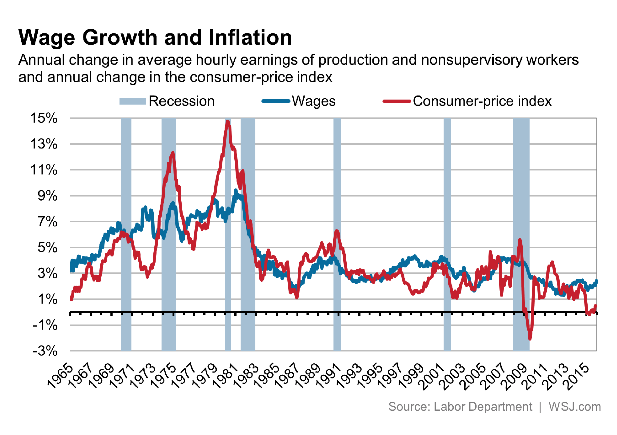
Before the 1970s, most households had one family member stay home and one person work. After the oil crisis and the spike in inflation of the 1970s, families needed two people working to maintain the same standard of living. The oil crisis and inflation of the 1970s caused the cost of living to rise substantially in the U.S.
Again, this is a major problem that many Americans face, the high cost of living, especially for education, healthcare, childcare, housing, and very little wage increases adjusted to inflation.
One of the problems healthcare faces is similar to other economic issues is, the diagnosis and prescriptions to our economic problems. For example, according to many Republicans, one of the keys to making healthcare more accessible and affordable is to let the free markets work to lower prices.
The problem with this thinking is that healthcare does not operate in a free market. Free markets need several conditions to exist:
Low barriers to entry – If you want to be a doctor, start a hospital, create a new pharmaceutical company the barriers to entry (capital, labor, regulations) are very high. Because the barriers to entry are high, you have less supply and higher prices.
Many competitors – To have free markets you need many competitors, supply. As mentioned above, high barriers to entry creates less supply and higher prices. Also, the consolidation of the healthcare industry has caused even fewer companies and supply.
For example, here is a list of the U.S. pharmaceutical companies that existed 20 years ago that were acquired or merged with a larger drug company:

We find the same consolidation among HMO/insurance and hospital supply companies.
If you would like to learn more about forms of competition including free markets, click on the link below. The many healthcare sectors and industries are considered oligopolies.
https://www.khanacademy.org/economics-finance- domain/microeconomics/perfect-competition-topic
The other problem healthcare has is that some health care services and drugs have inelastic demand. Below is a chart that illustrates the problem:
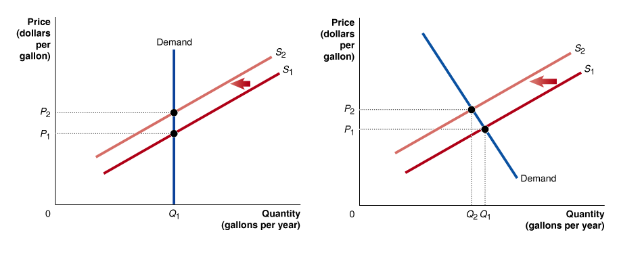
The chart on the right shows a product that has elastic demand; most products, services have elastic demand. Let’s suppose the chart is for orange juice. At low prices, demand will be higher (P1, Q1). At high prices demand will be lower (P2, Q2) because orange juice drinkers could switch to other juices, water, soda or other drinks. There are many competitors for drinks that satisfy thirst. With elastic demand a price change will impact demand.
Many healthcare services and drugs have what economists call inelastic demand. This is when there are no substitutes for a product or service causing high prices. A recent example was the lifesaving EpiPen.
Because it is a lifesaving drug, and there are very few substitutes, Mylan (manufacturer of EpiPen) was able to increase their prices dramatically. EpiPen had inelastic demand and therefore Mylan was able to increase prices dramatically since 2011.

EpiPen was not the only drug that had dramatic price increases due to inelastic demand. A change in price will not impact demand
If you would like to learn more about inelastic demand, click the link below.
https://www.khanacademy.org/economics-finance- domain/microeconomics/elasticity-tutorial/price-elasticity- tutorial/v/perfect-inelasticity- and-perfect- elasticity-of- demand
There are many ideas to control and reduce costs, but that is not what this article is about.
Again, HEALTHCARE DOES NOT HAVE FREE MARKETS, and therefore Republican plans to reduce healthcare costs won’t work as anticipated.
Late in Cycle
Most economic cycles last about 5 years, on average. Below is a chart that shows the length of each economic cycle since 1949:

This expansion began in the second quarter of 2009, so it’s in its seventh year and will soon be tied for the third longest expansion since 1949.
Many of President Trump’s agenda is stimulative, and these type of stimulus efforts have never been tried this late in the economic cycle, especially tax cuts and infrastructure and military spending.
These stimulative plans could cause this economic cycle to last longer, and it could make this the longest expansion on record.
Normally you would want these stimulus measures at the beginning of a cycle where it is needed most to get the economy going. Inevitably, we will have a recession and we will need these stimulus efforts then.
Infrastructure spending is badly needed, but it can help the economy better at the beginning of a cycle versus near the end of a cycle.
Normally at the beginning of an economic cycle unemployment is high, but near the end of a cycle unemployment is lower. Below is a chart that shows this relationship in this cycle:
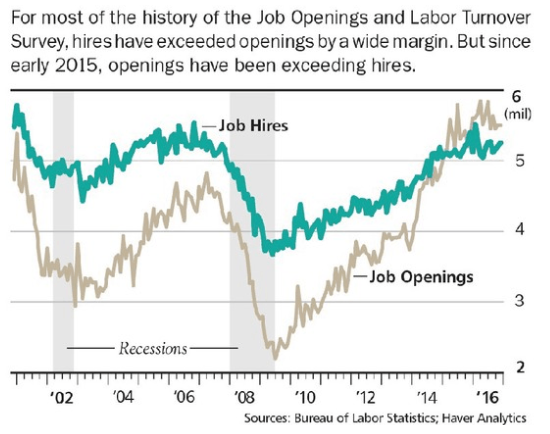
At the beginning of this cycle there were a lot more workers than job openings. Now, late in the cycle, there are more job openings than workers. Our economy is considered at full employment. Many of today’s workers don’t have the right skills for many of the current job openings.
If the stimulus works, there may not be enough qualified workers for new job openings. The one good thing about this is, if you’re looking for a job it is easier today to find one. Also, as we have fewer workers for employers to hire, this could push up wages for workers - less supply leads to higher prices.
With full employment and the proposed economic stimulus, it could lead to inflation, higher interest rates and this could lead to an end to this economic cycle. High interest rates and inflation are normally how most economic cycles end.
There should be programs for better training, education including intern and apprenticeships. Hopefully this becomes part of the administration’s agenda.
Geopolitical Concerns
There are many geopolitical concerns that the administration and this nation must pay attention to:
- North Korea and its recent missile launches are threats to the U.S. and our allies. The new Secretary of State, Rex Tillerson, has warned the North Koreans that military options are on the table.
- Iran, President Trump said he would tear up the Iranian nuclear agreement. Iran has warned the President not to. They have fired several missiles in defiance.
- Isis and other terrorist groups, are causing death and fear in the Middle East and in the U.S. and our allies.
- The U.S. has sent military operations to Yemen, Iraq, and Syria.
- Russia, and its increasing involvement in geopolitical hotspots: Libya, Syria, Ukraine, and efforts to influence elections in Europe. Russia continues to troll U.S. websites and blogs to change opinion in the U.S.
- China, tensions are rising between China and the U.S. over China’s economic policies and military ambitions.
Military conflicts with the above hotspots, could cause the U.S. and the global economy to enter into a recession.
Politics, Ideological Advisors
Politics and Republicans
One of the challenges for President Trump is creating a coalition among the disparate factions among the Republican Party that include: social and evangelical conservatives, establishment Republicans, Tea Party/Freedom Caucus, deficit and debt hawks, supply siders, global free traders, and a new group - populists.
We are learning that these opposing groups made it hard to pass a healthcare bill, and it will be difficult for these factions to agree on taxes, budgets and spending.
Think tanks like the Heritage Foundation and the American Enterprise Institute greatly influence Republican economic thinking and they are married to cutting taxes (supply-side- economics), free markets and global free trade. The policies they promote are ideological and have proven overtime not to work in the real world. They have been promoting these ideas for decades and they need to come up with something that works in our global economy.
Peter Navarro PhD, Economist
Most Republicans believe in free trade among our global trading partners. Dr. Navarro is the head of President Trump’s new National Trade Council, and he believes free trade has hurt America, especially its workers. Dr. Navarro is a public policy professor at the University of California at Irvine. He is also an author and his book, Death by China is very critical of China on many levels. He does have some interesting, non-conventional ideas on trade deficits.
If we look at the components of the U.S. GDP, they are:
GDP = The consumer (about 70% of GDP) + business investment (about 12.5%) Government (about 21% federal, state and local) + net exports (exports minus imports, about -4%).
Dr. Navarro’s idea is, to make the economy grow faster export more, and import less.
This means renegotiating our trade agreements and to go from trade deficits to trade surpluses. As the President always states, we want free trade, but also fair trade.
The fear among many business leaders and economists is that these trade negotiations could lead to tariffs, trade wars and a global recession.
Below are the countries with the largest trade deficits:
1. China -- $579 billion traded with a $347 billion deficit.
2. Canada -- $545 billion traded with a $11 billion deficit.
3. Mexico -- $525 billion traded with a $63 billion deficit.
4. Japan -- $196 billion traded with a $69 billion deficit.
5. Germany -- $164 billion traded with a $65 billion deficit.
These are the countries where trade negotiations are beginning to start. Getting countries to buy more of our products and services, and Americans to buy less foreign products is a lot easier said than done.
We have been exporting our standard of living for decades by buying Japanese and German luxury cars, foreign oil, Mexican agriculture and Mexican assembled vehicles….
Another important point regarding our trade deficits is the impact of the dollar and our financing needs. The U.S. dollar is the world currency reserve and many commodities are denominated in U.S. dollars. Also, because we are a large global trading partner and our business is done in U.S. dollars, these foreign reserves help us finance our debts, and investments, as the U.S. does not save enough.
Regarding the dollar, it has been strong since 2014, but it did have a strong rally after the elections. A strong dollar makes our U.S. products and services overseas more expensive. If the euro goes lower and the dollar gets stronger, a European who wants to buy a Chevy will have to have more Euros to buy a Chevy because they will need more euros to buy anything priced in dollars. In the early 2000s, a euro would buy about $1.60 worth of dollars. Today a euro only buys about $1. A strong dollar will make it harder to increase our exports. Below is a long-term chart of the dollar:
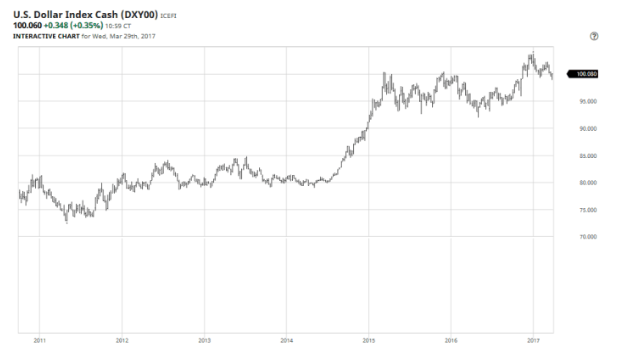
A strong dollar makes foreign goods cheaper for Americans, the dollar goes further in most countries, making it even harder to reduce our trade deficits.
Also our trading partners are not just about business. For example, we need Mexico to help stop the flow of drugs over the border. Admittedly once it’s stopped at the border it will come from somewhere else, perhaps from Columbia through Florida like the 1980s. Help with drug addiction, an epidemic in the U.S., and prevention is what is needed most. We also need Mexico to help stem the flow of refugees of violence and gangs from Central America.
Steve Bannon
Of all the Trump advisors and cabinet members, Steve Bannon (Trump’s Chief Strategist) is the most radical. His a very angry man and hates baby boomers, Washington establishment on the right and left, the media, liberals, globalists. cronyism… He is the main populist in the Trump administration.
At a recent CPAC meeting he spelled out the main objective for the Trump administration:
1. National security and sovereignty (this includes the travel bans and increasing deportations of undocumented workers) 2. Economic nationalism (making America first by renegotiating trade agreements, “Buy American, Hire American”) 3. Deconstruction of the administrative state or draining the swamp and this includes lobbyists, career politicians, socialist democrats, crony capitalism….
Click here to see the interview.
He believes the media is the opposition party and wants to delegitimize it. Almost every day I receive an email, newsletter from the White House explaining what the Trump administration is trying to accomplish. This is the administration’s effort to bypass the media and is propaganda.
I’ve read many articles about Mr. Bannon and have viewed some of the documentaries that he has written, directed, and produced. His documentary about Sarah Palin, the once governor of Alaska, does give you some insight on what he would like politics, and politicians to be. He sees Ms. Palin as an outsider, disrupting the establishment and a focus on voters, “the people”. He sees President Trump in a similar light.
He believes that the U.S. is ripe for a revolution, similar to the Civil War, the Great Depression, and WWII. He believes the global economic crisis of 2008 is the catalyst for the next major disruption for America and where America can become great again.
I would encourage readers to read some of these articles:
This is probably the most important article that explains who Steve Bannon is and what he wants.
This article boils down the 3 tenets of Mr. Bannon: Capitalism, nationalism, and Judeo-Christian values. Mr. Bannon believes this is what makes America great and America has moved away from these tenets. This sounds fine, BUT he believes liberals, immigrants, especially Muslims, Mexicans and other Latinos from Latin America are not true Americans and are diluting what it means to be American. As long as blacks, Hispanics, immigrants, Democrats believe in these tenets, then they are welcome in Bannon’s vision of America.
https://qz.com/898134/what-steve- bannon-really- wants/
This Man Is the Most Dangerous Political Operative in America
This article describes Mr. Bannon’s hatred of the Republican and Democratic establishment and elites, especially the Bushes and Clintons.
https://www.bloomberg.com/politics/graphics/2015-steve- bannon/
Steve Bannon and the Making of an Economic Nationalist
This story explains why Mr. Bannon is anti-establishment, especially towards Washington DC. His father lost money in the stock market crash in 2008, and he blames Washington. They helped Wall Street but not people like his father.
https://www.wsj.com/articles/steve-bannon- and-the- making-of- an-economic- nationalist-1489516113#livefyre-toggle- SB12087342390066674160404583010990765163574
Ringside With Steve Bannon at Trump Tower as the President Strategist Plots An Entirely New Political Movement"
This article was an interview right after the elections. In the interview he explains why he is a populist and a nationalist. The article, like some of the articles here explain who Steve Bannon is, his middle class roots, navy career, Harvard Business School graduate, Goldman Sachs alumni, and his activities in Hollywood.
http://www.hollywoodreporter.com/print/948747
What Steve Bannon Really Thinks
http://www.vanityfair.com/news/2017/03/what-steve- bannon-really- thinks
This highlights a Roman story about brothers who tried to help the working class. He sees himself as this effort to help the working class.
The article also writes about the Briebart website that he took over. The Trump presidential campaign does borrow ideas from the Briebart site, especially stories about Mexican undocumented workers and their crimes and economic abuses. These stories were certainly prominent during the election and are now highlighted on Fox news almost on a nightly basis. These stories creates fear and resentment among the Trump base making it easier for the Trump administration to deport more Mexicans and others from Latin America.
In the CPAC Bannon appearance he stated “If you think they’re going to give you your country back without a fight, you are sadly mistaken. Every day, it is going to be a fight.” Again see the interview link above to hear him say this will be a fight.
I would like to ask Mr. Bannon, how are you going to get over 300 million people to think and act alike, without deporting them? This sounds very un-American, and I believe it would make America boring. Hopefully President Trump will tell him “you’re fired”.
We are starting to see many protests against the Bannon and Trump agenda.
Social Unrest
There are many groups that are protesting against the Trump administration:
- Many women are upset about what then candidate Trump said in the Hollywood Access scandal. They also remember the insults he made toward his female presidential challengers and a wife of a challenger. They are also upset about changes the Republicans want in their healthcare plan including government defunding of Planned Parenthood.
- Environmentalists are very unhappy with the new EPA chief, and the rolling back of environmental regulations.
- The LBGT community is upset regarding V.P. Pence and his anti-gay initiatives he tried to pass in Indiana when he was governor. They are also concerned that the social conservatives and evangelicals would like to rollback LBGT rights.
- Mexicans, immigrants and their relatives, friends and supporters (many U.S. citizens of Mexican decent, farmers and other businesses that depend on U.S. Hispanic consumers and labor, the Catholic Church, cities with large Hispanic communities) are very concerned about the increase in deportations, and the breaking up of families. They are protesting the deportations and are asking for immigration reform.
They also deeply resent how they were portrayed as criminals by then presidential candidate Donald Trump in his presidential campaign, and how they are portrayed by Fox News and other conservative talk radio commentators and blogs. They would like their real story to be told, the hundreds of years of legacy they have in the
Americas, and the many contributions (food, music, art, entertainment, productive labor) they have made to the U.S., the Americas and the world.
The treatment of Muslims and Mexicans are scaring other immigrants. - Liberals, there has always been a rift between Democrats and Republicans. Republicans basically believe in low taxes and small government (as Ronald Reagan stated, government is not the solution, it’s the problem). Democrats believe that the government can solve some societal and environmental problems.
- Blacks remain upset about how Donald Trump the citizen tried to delegitimize President Obama with his birther comments and efforts. They are also insulted the way they were portrayed during the elections.
Steve Bannon is right, this will be a fight, and this includes social unrest. This can be disruptive to the economy and to Trump’s agenda.
Trump Scandals, Personality
There are several personal liabilities that Trump has that could get in the way of him achieving his goals, especially creating high paying jobs for those Americans that have been left behind:
- Russian ties? President Trump’s election team is under FBI investigation regarding collusion with Russians to sway the elections and more. The list of Trump’s team that is being implicated continues to grow: Jeff Sessions, Jared Kushner, Donald Trump Jr., General Michael Flynn, Roger Stone, Paul Manafort, and Carter Page. There are many stories in the financial press about the Trump team and their probable connections to Russian and Ukrainian businesses, banks, politicians and the Russian, Ukrainian underworld.
- Credibility, there are websites, and much has been written about the many untruths, and credibility issues President Trump has. Without creditability, it will make it hard to get things done in Washington, but also among our global allies and enemies. His credibility is having an impact on his poll numbers, they have dropped below 40%.
- Insults, the President seems to insult Republicans and Democrats alike. He also insults our allies and foes around the globe. How can you insult somebody, or a country or leader and expect them to co-operate with you? Perhaps more honey and less vinegar would be a better strategy.
Summary and Conclusion
- Trump’s agenda is ambitious and could help many Americans. His most important goal is to create/bring back high paying jobs for Americans that have been left behind economically.
- The most important Trump plans include: 1. Tax cuts and reform 2. Repatriation of profits over seas. 3. Deregulation 4. Infrastructure spending.
- Trump’s challenges include: 1. we are late in an economic cycle, and any administration would find it difficult to prolong it. The economic policies they plan to pass would be better utilized at the beginning of a cycle. 2. Ideological economic solutions that have been proven to be ineffective 3. Politics and rifts in the Republican Party 3. Many geopolitical concerns 4. Trump’s personality, Bannon, and scandals 5. Social unrest
- My future reports will explain why Trump’s economic agenda could help investors and other wealthy Americans due to tax cuts, deregulation, and repatriation of overseas profits. Unfortunately, these policies will probably not create millions of high paying jobs. He will probably disappoint his supporters and voters that voted for him because of his promise to them to bring back and create high paying jobs.
My next report will tackle tax reform and tax cuts.